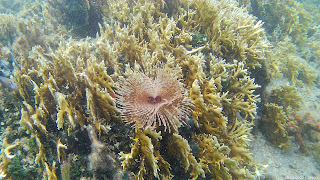Today
began with packing all of our belongings and saying goodbye (for now) to the
lovely Hostal Amador Familiar to begin our transit to the Smithsonian
Tropical Research Institute in Bocas Del Toro. We couldn't leave without
first making our mark on the massive chalk
wall amongst the many travelers that have had the
pleasure of passing through Hostal Amador Familiar (see if you can spot
Adriana's whale). Lastly, we utilized the opportunity for a last-minute selfie with the buff soccer player warning sign.
 |
| Me: glad my project partner Alex made it to Panama and I got to show her this sign!! |
After another round of boarding passes, security checks, and exchanges of luggage we were again miles above the ocean looking down into an endless blue. Upon reaching Bocas Del Toro, we were serenaded with beautiful, acoustic renditions of "Don't Worry Be Happy" and "Three Little Birds" that settled our post-flight jitters and welcomed us to paradise.
 |
our plane
|
 |
| the squid plane we wanted |
 |
the ocean from above |
When we arrived to the station, we were served the first of many incredible meals created by Desuze (and his assistant Cholla), the wonderful chef and human who will try to feed you canned apricots with much concern if you don't eat the pineapple upside down cake. After we were well-fed and trained up on the dos and do-nots of STRI, we could not wait to get into the water.
Two hours of snorkeling followed, during which we were able to get our first in-person glimpses of the incredible diversity of life that can be found just beneath the surface in Bocas Del Toro. Suddenly, all the travel and preparation was more than worth it. We encountered many species of fish (including territorial damselfish that defended their gardens like proud farmers), coral, urchins, sea cucumbers, worms, sponges, and an abundance of other organisms that we might not have been able to identify just yet. Maya and Richard were alongside us collecting various species of algae that we then took back to the lab to identify and study more closely.
Maya gave the first lecture on the marine algae found in Panama that revealed to us the identities of many of the algae that we had encountered during our first snorkeling excursion. We learned background information on the form and function of different kingdoms of algae, which allowed us to sort through the samples of algae brought back to lab into their genera. Despite the exhaustion that was palpable in the lab, we rallied around bins of algae including many tiny, invertebrate stowaways that revealed themselves as we picked through algae. Overall, the day was a success as we all made it safely to our home for the rest of our trip, became acquainted with our new setting, and got a taste of the incredible experience it is to observe organisms in their natural habitat. Personally, I fulfilled many childhood dreams today just being in the water and watching a damselfish watch me back. I cannot wait to experience the rest that this trip and the ocean have in store.
-Nadia
 |
| Cassiopea xamachana Upside-down jellyfish |
 |
| A tiny urchin stowaway that we found in an algae sample. If you look closely you can see the even tinier Aristotle's lantern. |
 |
| A tiny chiton stowaway found on a bivalve shell that was covered in encrusting coralline algae. |
 |
| Happy and exhausted snorkelers returning to air for discussions of what we encountered below. photo by Ryan McCarthy |
 |
| Urchin nestled in the seagrassphoto by Ryan McCarthy |
 |
| The ocean from below photo by Ryan McCarthy |
 |
| Pictured here is a sea cucumber not unlike the specimen Richard hurled at me, missing my face by a meter. photo by Ryan McCarthy |
 |
| Life on the docks at the Smithsonian Tropical Research Institutephoto by Ryan McCarthy |
 |
| Algae sample for sorting, which also contained tiny brittle stars, crabs, gastropods, urchins, and shrimp. |
 |
| Feather-duster worm photo by Ryan McCarthy |
 |
| Exhausted yet determined biologists identifying different genera of algae and picking invertebrates out while we're at it. |
 |
Microscope view of Acetabalaria sp.
|

















No comments:
Post a Comment